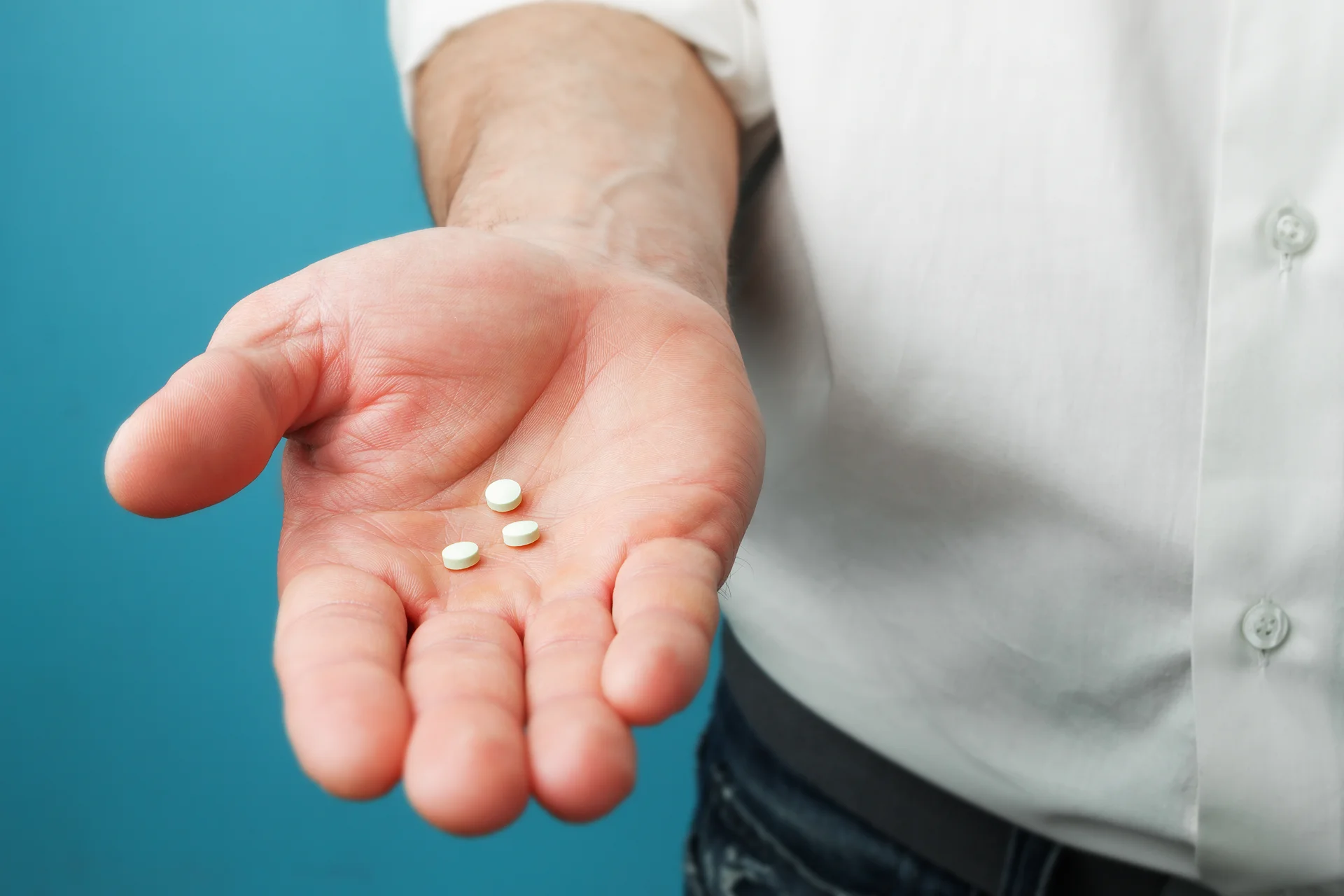Clomiphene Citrate (Clomid)
Bodybuilding Guide
Clomid is commonly known by its brand name "Clomid," but it is also available under other brand names such as "Serophene" and "Clomifene." The generic substance name for Clomid is Clomiphene Citrate.
Clomid, or Clomiphene Citrate, is a selective estrogen receptor modulator (SERM) that functions by binding to estrogen receptors in the hypothalamus. This action deceives the body into perceiving lower estrogen levels, which stimulates the release of gonadotropin-releasing hormone (GnRH). Subsequently, GnRH promotes the secretion of luteinizing hormone (LH) and follicle-stimulating hormone (FSH) from the pituitary gland. These hormones are crucial for triggering ovulation in women and enhancing testosterone production in men, making Clomid effective for both fertility treatments and post-cycle therapy in bodybuilding.
Content revised by:

Dr. Grant Fourie
Using Clomid (Clomiphene Citrate) for bodybuilding is off-label and not approved by health authorities. It carries potential risks such as hormonal imbalances and vision issues. Consult a healthcare professional before use. This information is for educational purposes only and not medical advice. Always prioritize safety and legal compliance.

What is Clomid and how it works
Selective Estrogen Receptor Modulator (SERM)
Clomid, scientifically known as Clomiphene Citrate, is classified as a Selective Estrogen Receptor Modulator (SERM). This classification means that Clomid can act both as an estrogen agonist and antagonist, depending on the tissue type. In the context of bodybuilding, understanding what Clomid is and how it functions is crucial for its effective use in post-cycle therapy (PCT). By binding to estrogen receptors, Clomid prevents estrogen from exerting its effects on certain tissues, particularly in the hypothalamus. This action is pivotal in its role in restoring hormonal balance.
Impact on Hypothalamus and Pituitary Gland
The primary mechanism of Clomid involves its interaction with the hypothalamus and pituitary gland. By blocking estrogen receptors in the hypothalamus, Clomid disrupts the feedback loop that typically regulates hormone production. This disruption leads the hypothalamus to perceive a deficiency in estrogen levels, prompting a compensatory response. This response is critical in understanding how Clomid works, as it directly influences the secretion of key hormones involved in testosterone production.
Stimulation of Gonadotropin-Releasing Hormone (GnRH)
As Clomid binds to estrogen receptors in the hypothalamus, it stimulates the release of Gonadotropin-Releasing Hormone (GnRH). GnRH is a pivotal hormone that signals the pituitary gland to produce and release luteinizing hormone (LH) and follicle-stimulating hormone (FSH). These hormones are essential for the stimulation of the testes to produce testosterone. This mechanism is fundamental to Clomid's role in post-cycle therapy (PCT), where restoring natural testosterone production is vital for maintaining muscle gains and overall hormonal health.
Clomid in Bodybuilding
Restoring Natural Testosterone Production
In the realm of bodybuilding, Clomid is predominantly used during post-cycle therapy (PCT) to restore natural testosterone production. After a cycle of anabolic steroids, the body's endogenous testosterone production is often suppressed. Understanding how Clomid works in this context is essential for bodybuilders looking to maintain their gains and hormonal balance. By stimulating the release of LH and FSH, Clomid helps kickstart the body's natural testosterone production, which is crucial for recovery and maintaining muscle mass post-cycle.
Maintaining Muscle Gains Post-Cycle
One of the significant challenges bodybuilders face after completing a steroid cycle is the potential loss of muscle gains due to suppressed testosterone levels. Clomid, by restoring natural testosterone production, plays a critical role in mitigating this issue. The use of Clomid in PCT helps ensure that testosterone levels return to normal, thereby supporting the maintenance of muscle mass and preventing the catabolic effects that can occur when testosterone is low. This aspect of Clomid's function highlights its importance in the bodybuilding community and underscores the need for a well-planned PCT regimen.
In summary, Clomid, or Clomiphene Citrate, is a powerful tool in the arsenal of bodybuilders for post-cycle therapy. By understanding what Clomid is and how it works, particularly its role as a SERM and its impact on the hypothalamus and pituitary gland, users can effectively utilize it to restore natural testosterone production and maintain muscle gains post-cycle.

Clomid Side Effects
Hot Flashes
One of the most frequently reported side effects of Clomid (Clomiphene Citrate) is hot flashes. These sudden feelings of warmth, particularly in the face, neck, and chest, occur due to hormonal fluctuations induced by the medication. Understanding how Clomid works can help manage this common side effect, as it often indicates the body's response to increased hormone activity.
Mood Swings
Mood swings are another prevalent side effect of Clomid, affecting both men and women. These emotional fluctuations can range from irritability to depression and are linked to the hormonal changes that Clomid triggers. Recognizing this side effect is crucial for maintaining mental well-being, especially for those undergoing post-cycle therapy (PCT) in bodybuilding.
Headaches
Headaches are a common complaint among Clomid users. This side effect can vary in intensity and duration, often resulting from the body's adjustment to the medication. Staying hydrated and managing stress levels can help alleviate this discomfort.
Nausea and Bloating
Some Clomid users may experience nausea and bloating. These gastrointestinal side effects are typically mild but can be uncomfortable. Eating smaller, more frequent meals and avoiding heavy, greasy foods can help mitigate these effects.
Breast Tenderness
Breast tenderness is another common side effect, particularly in women. This symptom is due to the hormonal changes that Clomid induces, similar to what occurs during a menstrual cycle. Wearing supportive bras and using over-the-counter pain relief can help manage this discomfort.
Less Common Side Effects
Visual Disturbances
Less commonly, Clomid can cause visual disturbances such as blurred vision or seeing spots. These symptoms are usually temporary but should be monitored closely. If they persist, it's important to consult a healthcare provider.
Ovarian Cyst Formation
In women, Clomid can sometimes lead to the formation of ovarian cysts. These cysts are typically benign and resolve on their own, but they can cause abdominal discomfort and should be monitored by a healthcare professional.
Abdominal Discomfort
Abdominal discomfort, including cramping and bloating, can occur with Clomid use. This side effect is generally mild and can be managed with over-the-counter pain relief and lifestyle adjustments.
Rare but Serious Side Effects
- Blurred or double vision
- Severe abdominal pain
- Significant weight gain
These rare but serious side effects warrant immediate medical attention, as they can indicate more severe underlying issues.
Reproductive System Effects
- Changes in menstrual flow
- Reduced cervical mucus production
- Thinning of uterine lining
These reproductive side effects are important for women using Clomid for fertility treatment to be aware of, as they can impact the likelihood of conception and pregnancy outcomes.
Psychological Effects
- Emotional sensitivity
- Irritability
- Sleep disturbances
Understanding that these psychological effects are common responses to hormonal changes can help manage expectations and stress. Implementing stress management techniques and maintaining open communication with loved ones can help mitigate these side effects.
Multiple Pregnancy Risk
Clomid increases the likelihood of multiple pregnancies, such as twins or triplets, due to its stimulation of multiple ovulations. While some may view this as a benefit, it's crucial to understand the increased risks and complications associated with multiple pregnancies and to discuss these with a healthcare provider.
How to use Clomiphene Citrate
Understanding the proper Clomid dosage is crucial for achieving desired outcomes, whether for fertility treatments or post-cycle therapy (PCT) in bodybuilding. This guide covers the most important aspects of Clomid dosage to help you use it safely and effectively.
Standard Clomid Dosage Range
The standard dosage range for Clomid (clomiphene citrate) varies based on its intended use:
- Fertility Treatments in Women: The typical starting dose is 50 mg daily for 5 days, usually beginning on the fifth day of the menstrual cycle. If ovulation does not occur, the dose may be increased to 100 mg in subsequent cycles.
- Fertility Treatments in Men: For addressing low testosterone or infertility, the dosage often ranges from 25 mg daily to 50 mg every other day.
- Bodybuilding and PCT: In the context of bodybuilding, Clomid is used to restore natural testosterone production after a steroid cycle. The dosage can vary but generally starts higher and tapers down over several weeks.
Clomid Dosage for Post Cycle Therapy (PCT)
For bodybuilders, Clomid is a popular choice for PCT due to its ability to stimulate natural testosterone production. A common PCT protocol might look like this:
- Week 1-2: 100 mg daily
- Week 3-4: 50 mg daily
- Week 5-6: 25 mg daily
This tapering approach helps the body gradually adjust and recover its hormonal balance.
Timing of Clomiphene Doses
Clomid is typically taken once daily. For optimal results and to maintain consistent blood levels, it is best to take Clomid at the same time each day. Some users prefer to split the daily dose into two smaller doses to ensure more stable hormone levels throughout the day.
Duration of Use
The duration of Clomid use depends on its purpose:
- Fertility Treatments: Usually prescribed for 5 days per cycle, up to 6 cycles.
- Clomid PCT in Bodybuilding: Typically lasts 4-6 weeks, depending on the intensity of the steroid cycle.
- Long-term Testosterone Support: May be used for several months under medical supervision.
Prolonged use should always be monitored by a healthcare professional to prevent potential side effects.
Factors Affecting Dosage
Several factors can influence the appropriate Clomid dosage:
Body Weight
Heavier individuals may require higher doses to achieve the same therapeutic effects. Dosage adjustments based on body weight can help optimize the effectiveness of Clomid.
Steroid Cycle Intensity
The intensity and duration of the steroid cycle can also impact the required Clomid dosage. More intense cycles may necessitate higher doses or a longer duration of use to fully restore natural hormone levels.
Individual Response
Individual response to Clomid can vary significantly. Some people may be more sensitive to its effects and require lower doses, while others may need higher doses to achieve the desired outcomes.
Tapering Protocols
Tapering the Clomid dosage can help minimize side effects and maintain hormonal balance. A typical tapering protocol might involve:
- Starting with the highest planned dose.
- Reducing the dose by 25-50% every 1-2 weeks.
- Continuing tapering until reaching the lowest effective dose or discontinuing use.
This gradual reduction helps the body adjust and maintain stability.
Potential Risks of Improper Dosing
Improper dosing of Clomid can lead to various side effects and health risks, including:
- Vision problems.
- Mood swings.
- Hot flashes.
- Nausea.
- Headaches.
- Overstimulation of the ovaries in women.
Long-term use or high doses may also increase the risk of certain cancers, though more research is needed to confirm this.
Monitoring and Adjusting Dosage
Regular blood tests are crucial for monitoring hormone levels and adjusting Clomid dosage accordingly. Key hormones to monitor include:
- Testosterone
- Luteinizing Hormone (LH)
- Follicle-Stimulating Hormone (FSH)
- Estradiol
Dosage adjustments should be based on these test results and any experienced side effects.
Combining Clomid with Other PCT Medications
Clomid is often combined with other medications during PCT, such as:
- Nolvadex (Tamoxifen): Often used alongside Clomid to enhance the recovery of natural testosterone production.
- hCG (Human Chorionic Gonadotropin): Used to stimulate the testes directly before starting Clomid.
- Aromasin (Exemestane): An aromatase inhibitor that helps control estrogen levels during PCT.

Clomid For Men
Effective Clomid Dosage for PCT
For men, especially bodybuilders, the dosage of Clomid during PCT is critical. Here’s a detailed breakdown:
- Initial Phase: Start with 100 mg daily for the first 1-2 weeks. This high dose is intended to jumpstart the body's natural testosterone production.
- Mid Phase: Reduce to 50 mg daily for the next 2 weeks. This helps maintain the momentum without overwhelming the body.
- Final Phase: Taper down to 25 mg daily for the last 1-2 weeks. This gradual reduction helps the body stabilize and adjust to normal hormone production.
Timing and Administration Tips
- Consistency: Take Clomid at the same time each day to maintain stable blood levels.
- Split Dosing: Some users find that splitting the daily dose into two smaller doses (e.g., morning and evening) can help maintain more consistent hormone levels.
- Diet and Hydration: Ensure you are well-hydrated and maintain a balanced diet to support overall health and recovery during PCT.
Monitoring, Adjusting Dosage, and Safety Considerations
Monitoring Hormone Levels
Regular monitoring of hormone levels is essential while using Clomid during PCT. Key hormones to track include:
- Testosterone: To ensure levels are returning to normal.
- Luteinizing Hormone (LH): Indicates the stimulation of testosterone production.
- Follicle-Stimulating Hormone (FSH): Important for overall reproductive health.
- Estradiol: Monitoring estrogen levels can prevent potential side effects like gynecomastia.
Adjusting Dosage Based on Response
- Initial Response: If you experience significant side effects or minimal improvement, consult with a healthcare provider to adjust the dosage.
- Gradual Adjustments: Reduce the dosage in small increments (e.g., 25 mg) to find the optimal balance that minimizes side effects while maintaining efficacy.
Combining Clomid with Other PCT Medications
For enhanced effectiveness, Clomid is often used in conjunction with other PCT medications:
- Nolvadex (Tamoxifen): Can be used alongside Clomid to further stimulate testosterone production and block estrogen receptors.
- hCG (Human Chorionic Gonadotropin): Often used before starting Clomid to directly stimulate the testes and jumpstart testosterone production.
- Aromatase Inhibitors (AIs): Such as Aromasin (Exemestane) can help control estrogen levels, preventing estrogen-related side effects.
Tips for Successful PCT
- Start PCT at the Right Time: Begin Clomid therapy approximately 2 weeks after your last steroid injection or 3 days after the last oral steroid dose, depending on the half-life of the steroids used.
- Healthy Lifestyle: Maintain a healthy lifestyle with a balanced diet, regular exercise, and adequate sleep to support recovery.
- Avoid Alcohol and Recreational Drugs: These can interfere with hormone recovery and overall health.

Clomid for Women
Understanding Clomid’s Role
Clomiphene Citrate (Clomid) is used to treat infertility in women by stimulating ovulation. It increases the production of hormones necessary for the growth and release of a mature egg.
Effective Dosage
- Starting Dose: Typically, 50 mg daily for 5 days, beginning on the fifth day of your menstrual cycle.
- Adjustments: If ovulation does not occur, the dose may be increased to 100 mg in subsequent cycles.
- Maximum Dosage: Generally, up to 150 mg daily, but higher doses are avoided due to increased side effects.
Timing and Administration Tips
- Cycle Day: Start on the fifth day of your menstrual cycle.
- Consistency: Take Clomid at the same time each day.
- Follow-Up: Regular monitoring with your healthcare provider to adjust dosage and track ovulation.
Monitoring and Adjustments
- Track Ovulation: Use basal body temperature charts, ovulation predictor kits, or ultrasound.
- Hormone Levels: Blood tests for estrogen and progesterone levels.
- Adjust Dosage: Based on response and side effects, consult your healthcare provider for adjustments.
Combining with Other Treatments
- Metformin: For PCOS to improve Clomid effectiveness.
- hCG: To trigger ovulation once a mature follicle is identified.
- IUI: Combining with intrauterine insemination can increase conception chances.
Tips for Success
- Timing Intercourse: Around ovulation, typically 5-10 days after starting Clomid.
- Healthy Lifestyle: Balanced diet, regular exercise, and adequate sleep.
- Stress Management: Techniques like yoga, meditation, or counseling.
Clomiphene Citrate Comparison
Clomid (Clomiphene Citrate)
- Use: Primarily used in Post Cycle Therapy (PCT) to restore natural testosterone production after anabolic steroid use.
- Mechanism: Selective estrogen receptor modulator (SERM) that blocks estrogen receptors in the hypothalamus, leading to increased production of follicle-stimulating hormone (FSH) and luteinizing hormone (LH).
Letrozole (Femara)
- Use: Occasionally used in PCT to manage estrogen levels and prevent estrogen-related side effects such as gynecomastia.
- Mechanism: Aromatase inhibitor that reduces estrogen levels, leading to increased production of FSH and LH.
- Unique Aspect: Different mechanism compared to Clomid; primarily reduces estrogen, which can help mitigate estrogenic side effects of steroid use.
Metformin
- Use: Sometimes used in bodybuilders with insulin resistance or to manage weight; not typically a primary PCT drug.
- Mechanism: Improves insulin sensitivity, which can help regulate blood sugar levels and potentially aid in maintaining lean muscle mass.
- Unique Aspect: Targets insulin resistance rather than directly influencing testosterone or estrogen levels.
Human Chorionic Gonadotropin (hCG) (Ovidrel, Pregnyl)
- Use: Used in PCT to stimulate the testes to produce testosterone, often before starting Clomid or other SERMs.
- Mechanism: Mimics luteinizing hormone (LH), directly stimulating the testes to produce testosterone.
- Unique Aspect: Directly stimulates testosterone production, often used in combination with Clomid or other PCT medications to jumpstart natural hormone production.
Follicle Stimulating Hormone (FSH) Preparations (Gonal-F, Follistim)
- Use: Less commonly used in bodybuilding; primarily used in fertility treatments.
- Mechanism: Directly stimulates the testes to produce sperm and testosterone.
- Unique Aspect: More potent and direct stimulation of the testes, but not typically a first-line treatment in PCT.
Black Cohosh (Cimicifuga racemosa)
- Use: Natural alternative sometimes considered for hormonal balance; limited use in bodybuilding.
- Mechanism: Believed to have estrogenic effects that may help balance hormones.
- Unique Aspect: Herbal remedy with some potential for hormonal regulation, but less robust clinical evidence and not commonly used in PCT.
Tamoxifen (Nolvadex)
- Use: Another SERM used in PCT to restore natural testosterone production and manage estrogen levels.
- Mechanism: Blocks estrogen receptors, leading to increased production of FSH and LH.
- Unique Aspect: Similar mechanism to Clomid but often used when Clomid is not well-tolerated or as an alternative in PCT protocols.
Anastrozole (Arimidex)
- Use: Occasionally used in PCT to control estrogen levels and prevent estrogen-related side effects.
- Mechanism: Aromatase inhibitor that reduces estrogen production, leading to increased FSH and LH levels.
- Unique Aspect: Similar to Letrozole but less commonly used for PCT; primarily reduces estrogen levels to prevent side effects like gynecomastia.
Summary
- Clomid vs. Letrozole: Both can be used in PCT, but Letrozole is an aromatase inhibitor that primarily reduces estrogen, while Clomid is a SERM that stimulates natural testosterone production.
- Clomid vs. Metformin: Metformin is used for managing insulin sensitivity and weight, not directly for PCT.
- Clomid vs. hCG: hCG directly stimulates testosterone production and is often used before Clomid in PCT to jumpstart the testes.
- Clomid vs. FSH Preparations: FSH preparations are more potent and used for direct stimulation of the testes, but less common in PCT.
- Clomid vs. Black Cohosh: Black Cohosh is a natural alternative with limited use and evidence in PCT.
- Clomid vs. Tamoxifen: Both are SERMs used in PCT, with Tamoxifen often used as an alternative to Clomid.
- Clomid vs. Anastrozole: Anastrozole is an aromatase inhibitor used to control estrogen levels, similar to Letrozole but less common in PCT.
Clomid Reviews
Had low T and felt terrible... got prescribed 25 mg clomid every other day (25 day cycle + 5 days off). Taking vitamind D 20 000 IU daily... Sleep, recovery, mood, energy, lifts - everything improved drasticly! - source: reddit.com
Also did clomid. Had similar side effects. Moved to HCG and major improvements. No sides, but felt really good. - source: reddit.com
Clomid is not for everyone. It sounds like it isn't working for you if it didn't increase libido. Most men start out with Clomid and move on to the big boy stuff. The Clomid may increase total test numbers without helping anywhere else. I am the exception as Clomid was great for me. I'm the only one out of my circle that had a positive result. You may have have to spring for the HCG if fertility is an issue. source: reddit.com
Buy Clomid
Where to Buy Clomid in US
When looking to buy Clomid in the USA, it is essential to have a valid prescription. You can purchase Clomid from:
- Local Pharmacies: Major chains like CVS, Walgreens, and Rite Aid.
- Online Pharmacies: Verified online pharmacies such as HealthWarehouse and GoodRx.
- Specialty Clinics: Fertility clinics and specialized hormone therapy centers.
High-quality Clomid for sale available to purchase online in US
Where to Buy Clomid in Canada
In Canada, Clomid is also a prescription medication. You can find Clomid at:
- Local Pharmacies: Shoppers Drug Mart, Rexall, and London Drugs.
- Online Pharmacies: Verified Canadian online pharmacies like Canada Drugs Direct and CanPharm.
- Fertility Clinics: Clinics specializing in reproductive health and hormone therapies.
Buy high-quality Clomid Online in Canada from trusted store.
Where to Buy Clomid Worldwide
Internationally, Clomid can be purchased with a prescription from:
- Local Pharmacies: Available in most countries through local pharmacies.
- Online Pharmacies: Trusted international online pharmacies like PharmacyChecker and Medix Pharmacy.
- Specialized Clinics: Fertility and hormone therapy clinics around the world.
High-Quality Clomiphene Citrate available to purchase online.

Clomid FAQ
Clomid works by blocking estrogen receptors in the hypothalamus, which stimulates the release of gonadotropin-releasing hormone (GnRH). This, in turn, increases the production of luteinizing hormone (LH) and follicle-stimulating hormone (FSH), leading to the stimulation of the testes to produce testosterone.
The optimal Clomid dosage for PCT typically starts with 50 mg per day for the first two weeks, followed by 25 mg per day for an additional two weeks. Dosage may vary based on individual response and the specifics of the steroid cycle.
Clomid is usually used for 4 to 6 weeks during PCT. The duration can vary depending on the length and intensity of the steroid cycle. Longer and more intense cycles may require extended PCT protocols.
Yes, Clomid can be used off-label to treat low testosterone levels in men who have not used steroids. It stimulates natural testosterone production by increasing LH and FSH levels.
Potential side effects of Clomid in men include visual disturbances, mood swings, headaches, and gastrointestinal issues. Higher doses can increase the risk of these side effects.
Clomid and Nolvadex (Tamoxifen) are both SERMs and are often used together for PCT. Clomid is generally more effective at stimulating overall testosterone production, while Nolvadex is better at blocking estrogen receptors in breast tissue. hCG is used to directly stimulate testosterone production by mimicking LH. Each has its own profile of effectiveness and side effects.
Clomid can help prevent gynecomastia by blocking estrogen receptors, particularly when used in combination with other anti-estrogen drugs. However, it is not as effective as aromatase inhibitors for this purpose.
Yes, by restoring natural testosterone production, Clomid helps maintain muscle mass and strength gains achieved during a steroid cycle. Proper PCT with Clomid can reduce the risk of muscle loss.
Results from Clomid can typically be seen within 2 to 4 weeks, with significant improvements in testosterone levels and related symptoms.
Long-term use of Clomid can lead to potential risks such as desensitization of the hypothalamic-pituitary-gonadal axis, visual disturbances, and other side effects. It is important to use Clomid under medical supervision and not for extended periods without breaks.
References
https://www.drnemseff.com/en/
https://www.drugs.com/clomid.html
https://www.webmd.com/drugs/2/drug-11204/clomid-oral/details
https://www.verywellhealth.com/clomid-5116569
https://www.rxlist.com/clomid-drug.htm
https://en.wikipedia.org/wiki/Clomifene
Author

Dr. Grant Fourie
Hi, I’m Dr. Grant Fourie, a dedicated medical professional passionate about advancing healthcare in our community. With 20+ years' of medical background, I strive to provide compassionate and innovative care to my patients. Outside the clinic, I enjoy sport and fitness hobbies, which keep me balanced and inspired.
- Dr. Grant Fourie#molongui-disabled-link
- Dr. Grant Fourie#molongui-disabled-link
- Dr. Grant Fourie#molongui-disabled-link
- Dr. Grant Fourie#molongui-disabled-link


